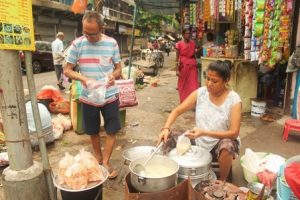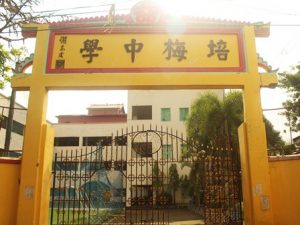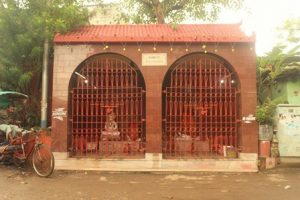Exploring the Remaining Ruins of Kolkata’s China Town
The Chinese legacy in Kolkata which was once well-renowned is sadly diminishing with time and modernization.
Background

In the late 18th Century, Chinese migrants came to Kolkata in search of a more stable lifestyle and hence gave birth to India’s only China Town. Earlier, people from the Chinese community mostly worked in the ports of Kolkata and settled around the central part of the city with their family. Named after the very first president of the Republic of China, Sun Yat-Sen Street is known as the old China Town of the city. Presently, it is popular among locals and tourists because of its unique street market and Chinese breakfast hub, Tirreti Bazaar. The area once hosted nearly 20,000 Chinese individuals. However, with the advent of modernization and the dwindling Chinese community over the years, they shifted towards Tangra, which is now known as the new China Town. The Chinese population in the city has now come down to a mere number of 1,000–2,000 inhabitants.
Tracing the Past
Kolkata is often considered to be the pot of cultural diversity. Since time immemorial, Kolkata has been home to various ethnic groups who immigrated to the city from different parts of the world. The Chinese community first set foot on the land during the British India period. Kolkata (then Calcutta) was the capital of the country and one of the most easily accessible metropolitan areas from China. This attracted many Chinese families to settle in Kolkata. ‘Our ancestors came here ages ago in search of ample work opportunities and a better way of living but my son is now settled abroad’, shared local resident Shea Wu, a 63-year-old Chinese–Indian lady, who was born and brought up inKolkata’s China Town.
Livelihood and Identity
The early Chinese residents were mostly engaged in the leather business in Tangra which was the base of the leather industry in Kolkata. They were also largely involved in the Chinese food and restaurant business, which ultimately introduced the famous Indian Chinese cuisine in the country. Unfortunately, the Indo-China war in 1962 gave rise to political tension between the two countries and the majority of existing Chinese people had to leave the country. Many among them even faced difficulty in attaining their citizenship. Moreover, in 1996, the Supreme Court banned the operation of tanneries due to increasing pollution and violation of environmental laws. More than 500 tanneries were ordered to be relocated from Tangra and Topsia. Many leather factories were permanently shut due to insufficient financial conditions required for shifting and the ones operating were evicted.
Also Read : India China And The Arab World Exploring New Dynamics
Due to the growing scarcity of economic opportunities and lack of official identity, the Chinese population in the city started shrinking and mass evacuation became an emerging trend.
Through the Lanes of Tirreti Bazaar

The once populated Chinese area is now deemed as a marketplace. Tirreti Bazaar is famous across the country and attracts tourists for its authentic Chinese breakfast. Although the number of Chinese food stalls is slowly decreasing as compared to the previous times, traversing through the now dingy lanes of Sun Yat-Sen Streets would take one to the Chhatawalla Gully: the centre of Kolkata’s Momo market. The market settles at the break of the dawn around 5am each day and wraps up latest by 8am. It usually welcomes a moderate crowd on weekdays but ultimately blooms in its glory on Saturdays and Sundays as it witnesses the maximum visitors.
The China market life at Tirreti Bazaar begins early as the city gradually wakes up. The sellers welcome their customers as the empty streets of the city comes alive, the birds chirp to welcome a new day and the aroma of authentic Chinese snacks fills the air despite the lack of proper hygiene in the surrounding.
The market area opens with an array of fresh fruits and vegetables as well as raw chicken and pork. The food stalls spread across the entire lane mostly consists of chicken, fish and pork items. Steamed momos, fried momos, dumplings, baos and soups are the most popular breakfast menus at a reasonable price. On the farthest corner of the street, Ms Bobby Wong sells momos, prawn chips and is known for her fish ball/pork ball soup. ‘I have been operating this stall for years but now the numbers of Chinese shopkeepers are much lesser. Earlier, the entire street was full of Chinese food stalls’, she recalls. The number of Chinese shops is indeed considerably low. One lone Chinese church stands on the street next to Tirreti Bazaar that only has a few Chinese visitors on Sundays. One popular Chinese medicine and provisional shop has now been closed as the last owner recently passed away. Even the residents of the local slums are mostly Bengalis with only 2–3 remaining Chinese families.
Life in the New China Town
The third or present generation of Chinese immigrants now resides in Tangra. China Town is renowned for its restaurant chains with famous hotels like Beijing, Big Boss, Hot Wok Village, Kim Li and Golden Joy among others and their authentic Chinese cuisines. It is the city’s ultimate destination for Chinese food and welcomes customers in large numbers every day. Further down the winding roads are large buildings and quarters where the present-day Indian Chinese and Hakka Chinese families stay. The medium of communication is mostly Chinese though some of them are well acquainted with English, Hindi and Bengali. Scooters are a common mean of transportation and are used by many in the Chinese locality. The Sing Chueng Sauce Factory is located in the same area and is one of the oldest Chinese sauce manufacturing factories in the city. There is also a centre that provides specific Chinese food products and condiments, namely, Pou Chong Brothers. Although these properties are still functioning, there are many that lie abandoned within the walls of China Town. One such property is the Chinese school, Pei May, which is now completely locked down. The school once had 1,000s of students but most of them have now enrolled in English medium schools across the city.
Also Read : The Manufacturing Story Why India Is Falling Behind China
Yet another popular landmark is the Chinese Kali Temple where the Chinese devotees of goddess Kali come to pray.

The temple often sees an amalgamation of both Bengalis and Chinese Indians who come together to worship the deity. Noodles and Chop Suey are often offered as the prasad or bhog. Nonetheless, the daily worships are now a rarity. As reported by the local shopkeepers, there is no specific priest in the temple that was once looked after by caretaker John Cheng. Nowadays, few Chinese Hindus come together on specific days to organize a worship ceremony.
The vibrant and lively China Town now shelters the last few generations of Chinese Indians. It rises above the influence of any political or social hindrance in the broader world. It serves as a place where different ethnic groups and communities co-exist. The Chinese New Year is still celebrated with great pomp and show in the area. Chinese restaurants still welcome guests regardless of their ethnicity. The shops and business continue to be led by both the Chinese and Indians. And irrespective of the lost glory, the last remnants of India’s China Town is the Chinese community’s own little world, a tiny city of their own within the larger metro city.
